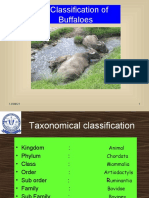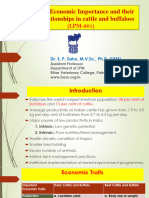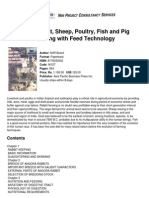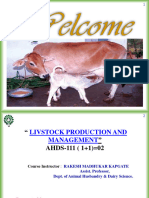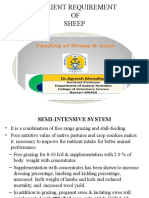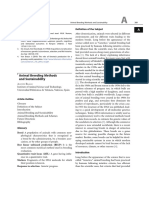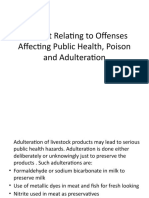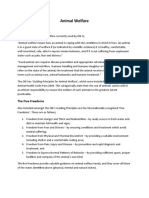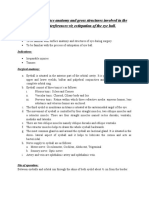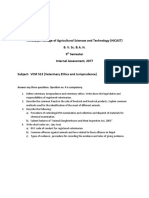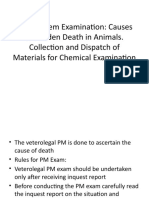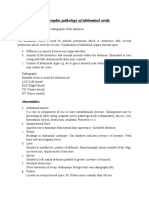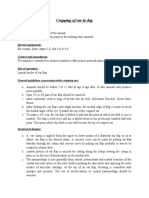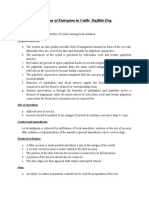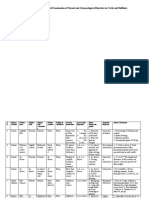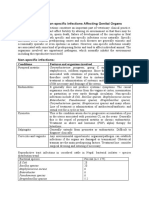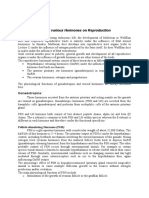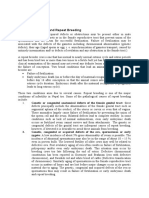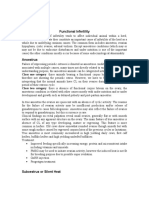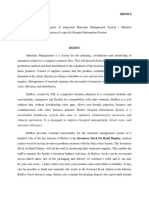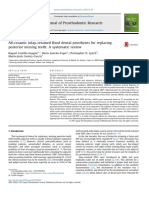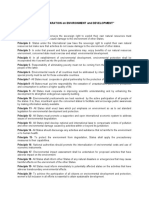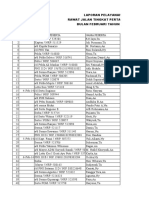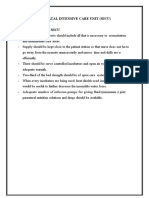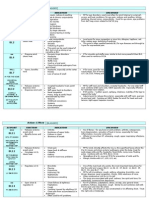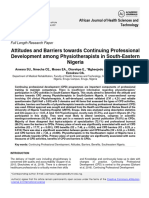TCP/NEP/3105
Dairy cattle improvement
B.V. Sc & A.H
IV-SEMESTER
LIVESTOCK BREEDING SYSTEM
Lecture XII:- Performance records and standardization
The main purpose of recording for farm animals according to Lerner and Donald (1966) are
some or all of the followings:
1. Selective breeding
2. Management
3. Research
4. Publicity
The animal breeding plan start with selection goals for selection of parents of next
generations through the use of statistical tools for information from performance records of
individuals, pedigree and relatives from birth to lifelong records for economically important
traits. The following figure show the importance of records and their linkages for genetic
improvement programmes for dairy animals.
Why animal recording?
Animal farming is dynamic and complicated enterprise having the objective of increasing
productivity and profit.
Purpose of Record keeping:
i. To know the pedigree and history of each animals regarding production,
reproduction and health performance
1
� TCP/NEP/3105
Dairy cattle improvement
a. Help to compare and evaluate the herd performance within breed as well as
breed comparison
b. Breeding value can be estimated and helping selection and culling based on
breeding value
c. Appropriate feeding level can be managed on the basis of production
d. Fixing the price of animal
e. Research and development
ii. To know the proper growth of young stock for selection and culling
iii. To avoid duplicate of number to different animals
iv. To have input output analysis for profit making
v. To know the financial status of the farm
vi. To know the health status of the animal
Type of records:
i. Pedigree and history record
ii. Birth records
iii. Growth register
iv. Daily treatment register
v. Livestock stock register
vi. Daily milking register
vii. Milk feeding register
viii. Feed and fodder register
ix. Sale and mortality register
x. Cash book
Standardization of records
To standardize the data the records of some animals are excluded before analysis of data to
study the effects of various environmental factors like year, season, and parity of lactation.
Such records are on the following animals:
The incomplete records due to death or culling of the cows or buffalo during
lactation
The records of animals which dries up before 100 days of lactation, depending upon
the nature of the traits under study. Such records are excluded for 305
days/lactation milk estimation
The milk records following abnormal calving
Abnormal extreme data are also excluded
2
� TCP/NEP/3105
Dairy cattle improvement
Data generation
Two categories of data on traits:
a. Directly observed traits: which are observed and measured directly on
animals which are s follows:
b. Body weight, growth and development: Birth weight, Body weight at
different ages, body measurements, (Length, girth, height), measurements
of various body parts,
c. Birth records and reproductive traits : Types of calf birth (Normal, abnormal)
sex of calf, condition of calf (twin or single, dead or alive or weak, normal ) ,
date of mating, date of calving, litter size at birth, litter size at weaning, litter
weight,
d. Physiological traits (body temperature, pulse rate, respiration rate),
Physiological defects
e. Production traits: milk yield, milk composition (fat %, SNF, Protein %,
conductivity), Greasy fleece weight, carcass weight, egg weight,
f. Health records: Incidence of diseases, records, treatments,
g. Polymorphic/biochemical/molecular traits: blood group, protein
polymorphism, hemoglobin and potassium types in the blood, molecular
markets,
1. Traits which are generated: Most of the economic traits in farm animals are
generated from the pedigree and other information measured directly on animals.
a. Reproductive traits: Age at sexual maturity, Age at first calving, post partum
period, service period, gestation period, calving interval, fertility index of
bull with respect to insemination,
b. Production traits: lactation length, Dry period, 305 day milk yield, life time
milk production, life span,
Data correction
The phenotypic value for milk, meat, egg, wool and reproducing ability is the joint product of
genotypes of the animal and environment received by it during the course of development
and expression of characters. The environmental factors can be grouped as under:
a. Random environment which includes sampling error and error in data
recording
b. Environment factor which may be year, season, feeding level and standard,
health status, heat/cold stress, management level etc.
c. Physiological status which includes service period, dry period, lactation
length, age and body condition
These environmental factors mask the true breeding value of animal. The reduction of the
environmental sources of variation is needed to have true breeding value of animal. The
purpose of correcting the data is to minimize and reduce the environmental sources of
variation so that the true breeding value can be estimated more accurately. This is called
correction or adjustment of data to minimize the environmental variation.
3
� TCP/NEP/3105
Dairy cattle improvement
Q-1. What are the purposes of record keeping? Give the purposes of data correction.
Q-2. Describe in brief the linkages among breeding objectives, pedigree performance
records keeping and information on individuals and relatives, statistical tools for analysis of
the data and selection of the parent for mating to produce future progenies for dairy cattle.
Q-3. Describe the traits based on data that are observed and measured directly on
animals. What other traits can you generated from such data.
4
� TCP/NEP/3105
Dairy cattle improvement
Annex 3
Proposed Forms for the Pedigree and Performance Recording
Scheme for Nepal Dairy Cattle
15 October 2008
File: Forms_Nepal_20081016_long.doc
Form 1: Herd (and Farm) Registration; separate page; used only once at
the start of the programme or when a new herd joins the
scheme.
Form 2: Base Animals Identification and Registration; separate page for
each herd; used only once at the start of the programme or
when a new herd joins the scheme.
Form 4: Milk Content; separate page for each herd; is coming from the
lab; might perhaps not be needed if data can be transferred
directly from the printing slip of the analysis machine to the
computer.
Form 5: Weight (kg); separate page for each herd; used two times a year
in every herd; might be printed by the computer with numbers
pre-printed if the data are all in the computer.
Form 6a: Artificial Insemination; is filled in by the AI technician.
Form 12: AI Technician is filled by the AI Station
Form 13: Tagging List; is filled by the recorder and handed over to the
Service Centre, which is doing the tagging. It has to be handed
in at least monthly.
Form 14: Herd – Lab – DMU accompanying Form
Form 15: Farmer’s Notes
Form 16: Check List used by the Data Management Unit
All the other forms
Form 3: Milk Yield
Form 6b: NS/AI (natural service and insemination)
Form 7: Birth (Calving)
Form 8: Exit (Culling)
Form 9: Health (Disease and Treatment)
Form 10: Movement of animals from one recorded herd to another
recorded herd
Form 11: Base Animal Registration of entering animal coming from a
non-recorded herd might be combined (depending on the size
of the herd) and filled out every month by the milk recorder.
See File: Forms_Nepal_20081016_short.doc
5
� TCP/NEP/3105
Dairy cattle improvement
Cattle Recording in Nepal - Form 3: Milk Yield
Farmer’s name: ID_Herd: Date:
Milk yield Milk yield
Sample Name of Sample
Name of Cow ID ID
Code Cow Code
Pm am pm am
Done on (date): by (name): Signature:
First data entry (name): Second data entry (name): Checked+appended:
6
� TCP/NEP/3105
Dairy cattle improvement
Cattle Recording in Nepal - Form 6b: Natural Service/Artificial Insemination (NS/AI)
Farmer’s name: ID_Herd: Date:
Name of Date of Technician/
ID_Cow Name of Bull ID_Bull NS/AI
Cow NS/AI Comment
NS/AI: [NS = 1, AI =2]
Done on (date): by (name): Signature:
First data entry (name): Second data entry (name): Checked+appended:
7
� TCP/NEP/3105
Dairy cattle improvement
Cattle Recording in Nepal - Form 7: Calving and Birth
Farmer’s name: ID_Herd: Date:
Name- Date of Type Ease Birth Date of
Com-
ID_Cow n ID_Calf sex Fate
Cow Calv./Birth Birth Birth Weight weighing ment
Type Birth (Calving): [1=normal, 2=pre-mature, 3= abortion]; Ease Birth: [1=easy,
2=considerable assistant, 3=vet. Assistant incl. Caesarien)]; n-Kids: [1=single, 2=twins,
3=triplets, 4=quadruplets]; Sex: [1=male, 2=female]; Fate of Calf: [1=alive, 2=dead]; Birth
Weight: [xx kg]
Done on (date): by (name): Signature:
First data entry (name): Second data entry (name): Checked+appended:
8
� TCP/NEP/3105
Dairy cattle improvement
Cattle Recording in Nepal - Form 8: Culling/Exit
Farmer’s name: ID_Herd: Date:
Name of Date of
ID Reasons for Exit Comments
Animal Exit
Reason of Exit: [1=culled (low yield), 2=old age, 3=sick, 4=died, 5=sold for use,
6=sold for slaughter (males); 7=other]
Done on (date): by (name): Signature:
First data entry (name): Second data entry (name): Checked+appended:
9
� TCP/NEP/3105
Dairy cattle improvement
Cattle Recording in Nepal - Form 9: Health (Disease and Treatment)
Farmer’s name: ID_Herd: Date:
Name of Date of Com-
ID Symptoms Diagnosis Drug used
Animal Sickness ments
Vaccination against: What animals (all)?:
Done on (date): by (name): Signature:
First data entry (name): Second data entry (name): Checked+appended:
10
� TCP/NEP/3105
Dairy cattle improvement
Cattle Recording in Nepal - Form 10: Movement (animal comes from another
recording herd)
Farmer’s name: ID_Herd: Date:
Current Current Old Herd’s Old Date of
Name of
Herd’s ID Comments
ID_Herd Name ID_Herd Animal Move
Name
Done on (date): by (name): Signature:
First data entry (name): Second data entry (name): Checked+appended:
11
� TCP/NEP/3105
Dairy cattle improvement
Cattle Recording in Nepal-Form 11: Base Animal Registration (animal comes from a non-
recording herd)
Farmer’s name: ID_Herd: Entry Date: Entry Type:
ID Name of Date of Breed Breed Com-
ID_old Sex ID_Sire ID_Dam
(new) Animal Birth Sire Dam ment
Entry Type: [1=start of programme, 2=from outside, 3=other]; Sex: [1=male, 2=female,
3=castrate]
Breed: [01=Local, 02=Local Cross, 03=Black and White, 04=Holstein Friesian, 05=Holstein
Friesian Cross; 99=Other]
Done on (date): by (name): Signature:
First data entry (name): Second data entry (name): Checked+appended:
12
� TCP/NEP/3105
Dairy cattle improvement
Cattle Recording in Nepal - Form 4: Milk Content
Farmer’s name: ID_Herd: Date of milking:
Sample Conduc- Sample Conduc-
ID Fat% Prot% ID Fat% Prot%
Code tivity Code tivity
Done on (date): by (name): Signature:
First data entry (name): Second data entry (name): Checked+appended:
13
� TCP/NEP/3105
Dairy cattle improvement
Cattle Recording in Nepal - Form 5: Weight (xxx kg)
Farmer’s name: ID_Herd: Date:
Name of Animal ID Weight Name of Animal ID Weight
Done on (date): by (name): Signature:
First data entry (name): Second data entry (name): Checked+appended:
14
� TCP/NEP/3105
Dairy cattle improvement
Cattle Recording in Nepal - Form 6a: Artificial Insemination
AI CERTIFICATE No: Date:
Name of ID_Herd
Farmerof Cow
Name ID_Cow
Name of Bull ID_Bull
Type of AI First Repeat Double Synchronization
Name of ID_Technician
Technician
Signature
Cattle Recording in Nepal - Form 12: AI - Technicians
Name of Date of
ID_Technician Address
Technician Start
Done on (date): by (name): Signature:
First data entry (name): Second data entry (name): Checked+appended:
15
� TCP/NEP/3105
Dairy cattle improvement
Cattle Recording in Nepal - Form 14: Herd – Lab - DMU
Farmer’s name: ID_Herd:
--------------------------------------------------------------------------------------
Date of milk recording:
Number of sample bottles:
Name of Recorder:
--------------------------------------------------------------------------------------
Date of Milk Analysis:
Name of Analyst:
-------------------------------------------------------------------------------------
Cattle Recording in Nepal - Form 14: Herd – Lab - DMU
Farmer’s name: ID_Herd:
--------------------------------------------------------------------------------------
Date of milk recording:
Number of sample bottles:
Name of Recorder:
--------------------------------------------------------------------------------------
Date of Milk Analysis:
Name of Analyst:
-------------------------------------------------------------------------------------
16
� TCP/NEP/3105
Dairy cattle improvement
Cattle Recording in Nepal - Form 14: Herd – Lab - DMU
Farmer’s name: ID_Herd:
--------------------------------------------------------------------------------------
Date of milk recording:
Number of sample bottles:
Name of Recorder:
--------------------------------------------------------------------------------------
Date of Milk Analysis:
Name of Analyst:
-------------------------------------------------------------------------------------
17
� TCP/NEP/3105
Dairy cattle improvement
Cattle Recording in Nepal - Form 1: Herd Identification
Owner’s
First and Owner’s Date of
ID_Herd Village – Ward VDC District
Middle Family Name Entry
Name
Done on (date): by (name): Signature:
First data entry (name): Second data entry (name): Checked+appended:
18
� TCP/NEP/3105
Dairy cattle improvement
Cattle Recording in Nepal - Form 2: Base Animal Identification and Registration
Farmer’s name: ID_Herd: Date of entry: Entry Type:
Breed Breed
ID ID_old Name of Animal Date of Birth Sex ID_Sire ID_Dam Comment
Sire Dam
Entry Type: [1=start of programme, 2=from outside, 3=other]; Sex: [1=male, 2=female, 3=castrate]Breed: [1=Jersey, 2=Holstein Friesian, 3=Brown Swiss,
4=Ayrshire, 5=Hariana, 6=Sahiwal, 7=Terai, 8=Pahadi, 9=Jersey x Local (=F1-Jersey); 10=Jersey x F1-Jersey; 11=Holstein Friesian x Local (=F1-Holstein
Friesian); 12=Holstein Friesian x F1-Holstein Friesian; 13=Holstein Friesian x Jersey (more Holstein); 14=Jersey x Holstein Friesian (more Jersey); 15=Brown
Swiss-Local; 16=Ayrshire-Local, 98=Buffalo; 99=Other]
Done on (date): by (name): Signature:
First data entry (name): Second data entry (name): Checked+appended:
1
� TCP/NEP/3105
Dairy cattle improvement
Cattle Recording in Nepal - Form 13: Tagging List
Recorder’s name: Date of Report:Name of rvice Centre: Signiture:
First-
Date Name
Village- Middle + ID
VDC ID_Herd Category ID_dam of of
Ward Family tagged
tagging Tagger
Name
Category: [calf; cow; bull]
Date sent to Data Management on: by (Name):
Signiture:
1
� TCP/NEP/3105
Dairy cattle improvement
Form 15 – Farmer’s Notes Month: … Nepal Livestock Improvement
Farmer’s Name ID_Herd
Calving record Mating record Disease record
Cow Sex AI/
ID_Cow Date Date ID_Bull Date Symptoms Diagnosis Drugs used
name calf NS
1
2
3
4
5
6
7
8
9
10
11
12
13
14
15
16
2
� TCP/NEP/3105
Dairy cattle improvement
Cattle Recording in Nepal - Form 16: Check List for the Data Management Unit (DMU)
Form Form Form Form
Form 7 Form 8 Form 9 Form 4 Form 5
Date of Milk Milk Recor-ding 3 6b 10/11 6a
Recording Forms handed in Milk Milk
NS/AI Birth/Calving Exit/Culling Health/Disease Movement AI Weight
Yield Content
ID_Herd
Date Date Tick tick tick tick tick tick Date Date Date
3
� TCP/NEP/3105
Dairy cattle improvement
Annex 3a
Recording forms short version
Farmer’s name:
ID_Herd: Date:
Form 3: Milk Yield
Milk yield Milk yield
Sample Sample
Name of Cow ID Name of Cow ID
Code Code
pm am pm am
Form 6b: Natural Service/Artificial Insemination (NS/AI)
Technician/
Name of Cow ID_Cow Date of NS/AI Name of Bull ID_Bull NS/AI
Comment
NS/AI: [NS = 1, AI =2]
4
� TCP/NEP/3105
Dairy cattle improvement
Form 7: Calving and Birth
Date of Type Ease Birth Date ofCom-
Name-Cow ID_Cow n ID_Calf sex Fate
Calv./Birth Birth Birth Weight weighing ment
Type Birth (Calving): [1=normal, 2=pre-mature, 3= abortion]; Ease Birth: [1=easy, 2=considerable
assistant, 3=vet. Assistant incl. Caesarien)]; n-Kids: [1=single, 2=twins, 3=triplets, 4=quadruplets]; Sex:
[1=male, 2=female]; Fate of Calf: [1=alive, 2=dead]; Birth Weight: [xx kg]
Form 8: Culling/Exit
Date of
Name of Animal ID Reasons for Exit Comments
Exit
Reason of Exit: [1=culled (low yield), 2=old age, 3=sick, 4=died, 5=sold for use,
6=sold for slaughter (males); 7=other]
5
� TCP/NEP/3105
Dairy cattle improvement
Form 9: Health (Disease and Treatment)
Date of Com-
Name of Animal ID Symptoms Diagnosis Drug used
Sickness ments
Vaccination against: What animals (all)?:
Form 10: Movement (animal comes from another recording herd)
Current Current Old Herd’s Old Name of Date of
ID Comments
Herd’s Name ID_Herd Name ID_Herd Animal Move
6
� TCP/NEP/3105
Dairy cattle improvement
Form 11: Base Animal Registration (animal comes from a non-recording herd)
Name of Breed Breed Com-
ID (new) ID_old Date of Birth Sex ID_Sire ID_Dam
Animal Sire Dam ment
Entry Type: [1=start of programme, 2=from outside, 3=other]; Sex: [1=male, 2=female, 3=castrate]
Breed: [1=Jersey, 2=Holstein Friesian, 3=Brown Swiss, 4=Ayrshire, 5=Hariana, 6=Sahiwal, 7=Terai,
8=Pahadi, 9=Jersey x Local (=F1-Jersey); 10=Jersey x F1-Jersey; 11=Holstein Friesian x Local (=F1-Holstein
Friesian); 12=Holstein Friesian x F1-Holstein Friesian; 13=Holstein Friesian x Jersey (more Holstein);
14=Jersey x Holstein Friesian (more Jersey); 15=Brown Swiss-Local; 16=Ayrshire-Local, 98=Buffalo;
99=Other]
Done on (date): by (name): Signature:
First data entry (name): Second data entry (name): Checked+appended:
